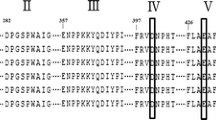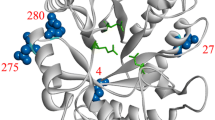Abstract
The gene encoding thermostable α-amylase from Bacillus licheniformis consisting of 483 amino acid residues (mature protein) was cloned and expressed in Escherichia coli under the control of T7 promoter. The analysis of the soluble and insoluble fractions after lyzing the host cells revealed that recombinant α-amylase was produced in insoluble aggregates. Despite being produced in the insoluble aggregates the recombinant enzyme was highly active with a specific activity of 408 U/mg.
Similar content being viewed by others
Abbreviations
- CAZy:
-
Carbohydrate-Active enZyme
- CBB:
-
Coomassie brilliant blue
- GHs:
-
glycoside hydrolases
- IPTG:
-
isopropyl-β-D-thiogalactopyranoside
- LB:
-
Luria Bertani
- PAGE:
-
polyacrylamide gel electrophoresis
- PCR:
-
polymerase chain reaction
- SDS:
-
sodium dodecyl sulfate
References
Bertoldo C. & Antranikian G. 2002. Starch hydrolyzing enzymes from thermophilic archaea and bacteria. Curr. Opin. Chem. Biol. 6: 151–160.
Bradford M.M. 1976. A rapid and sensitive method for the quantitation of microgram quantities of protein utilizing the principle of protein-dye binding. Anal. Biochem. 72: 248–254.
Cantarel B.L., Coutinho P.M., Rancurel C., Bernard T., Lombard V. & Henrissat B. 2009. The Carbohydrate-Active EnZymes database (CAZy): an expert resource for Glycogenomics. Nucleic Acids Res. 37 (Database issue): D233–D238.
Gangadharan D., Sivaramakrishnan S., Nampoothiri K.M. & Pandey A. 2006. Solid culturing of Bacillus amyloliquefaciens for α-amylase production. Food Technol. Biotechnol. 44: 269–274.
Gangadharan D., Sivaramakrishnan S., Nampoothiri K.M., Sukumaran R.K. & Pandey A. 2008. Response surface methodology for the optimization of α-amylase production by Bacillus amyloliquefaciens. Biores. Technol. 99: 4597–4602.
Henrissat B. 1991. A classification of glycosyl hydrolases based on amino acid sequence similarities. Biochem. J. 280: 309–316.
Hockney R.C. 1994. Recent developments in heterologous protein production in Escherichia coli. Trends Biotechnol. 12: 456–463.
Janecek S. 1997. α-Amylase family: molecular biology and evolution. Progr. Biophys. Mol. Bio. 67: 67–97.
Janecek S. & Sevcik J. 1999. The evolution of starch-binding domain. FEBS Lett. 456: 119–125.
Janecek S., Svensson B. & MacGregor E.A. 2003. Relation between domain evolution, specificity, and taxonomy of the α-amylase family members containing a C-terminal starch-binding domain. Eur. J. Biochem. 270: 635–645.
Jorgensen S., Vorgias C.E. & Antranikian G. 1997. Cloning, sequencing, characterization and expression of an extracellular α-amylase from the hyperthermophilic archaeon Pyrococcus furiosus in Escherichia coli and Bacillus subtilis. J. Biol. Chem. 272: 16335–16342.
Kuriki T., Takata H., Yanase M., Ohdan K., Fujii K., Terada Y., Takaha T., Hondoh H., Matsuura Y. & Imanaka T. 2006. he concept of the α-amylase family: a rational tool for interconverting glucanohydrolases/glucanotransferases, and their specificities. J. Appl. Glycosci. 53: 155–161.
Lin L.L. & Hsu W.H. 1997. Lactose-induced expression of Bacillus sp. TS-23 amylase gene in E. coli regulated by a T7 promoter. Lett. Appl. Microbiol. 24: 365–368.
Machovic M., Svensson B., MacGregor E.A. & Janecek S. 2005. A new clan of CBM families based on bioinformatics of starchbinding domains from families CBM20 and CBM21. FEBS J. 272: 497–513.
Machovic M. & Janecek S. 2006. The evolution of putative starchbinding domains. FEBS Lett. 580: 6349–6356.
Marco J.L., Bataus L.A. & Valencina F.F. 1996. Purification and characterization of a truncated B. subtilis α-amylase produced by E. coli. Appl. Microbiol. Biotechnol. 44: 746–752.
Marston F.A.O. 1986. The purification of eukaryotic polypeptides synthesized in Escherichia coli. Biochem. J. 240: 1–12.
Oslancova A. & Janecek S. 2002. Oligo-1,6-glucosidase and neopullulanase enzyme subfamilies from the α-amylase family de-fined by the fifth conserved sequence region. Cell. Mol. Life Sci. 59: 1945–1959.
Park C.S., Chang C.C. & Kim J.Y. 1997. Expression, secretion, and processing of rice α-amylase in the Yarrowia lipolytica. J. Biol. Chem. 272: 6876–6881.
Rashid N., Cornista J., Ezaki S., Fukui T., Atomi H. & Imanaka T. 2002. Characterization of an archaeal cyclodextrin glucanotransferase with a novel C-terminal domain. J. Bacteriol. 184: 777–784.
Rashid N., Shimada Y., Ezaki S., Atomi H. & Imanaka T. 2001. Low-temperature lipase from a psychrotrophic Pseudomonas sp. strain KB700A. Appl. Environ. Microbiol. 67: 4064–4069.
Rivera M.H., Lopez-Munguia A., Soberon X. & Saab-Rincon G. 2003. α-Aamylase from Bacillus licheniformis mutants near to the catalytic site: effects on hydrolytic and transglycosylation activity. Protein Eng. 16: 505–514.
Sambrook J., Fritsch E.F. & Maniatis T. 1989. Molecular Cloning: A Laboratory Manual, 2nd Ed., Cold Spring Harbor Laboratory Press, Cold Spring Harbor Laboratory, New York, ISBN 0-87969-309-6.
Shahhoseini M., Ziaee A.A. & Ghaemi N. 2003. Expression and secretion of an α-amylase gene from a native strain of Bacillus licheniformis in Escherichia coli by T7 promoter and putative signal peptide of the gene. J. Appl. Microbiol. 95: 1250–1254.
Sibakov M. 1986. High expression of Bacillus licheniformis α-amylase with Bacillus secretion vector. Eur. J. Biochem. 155:577–581.
Sivaramakrishnan S., Gangadharan D., Nampoothiri K.M. & Pandey A. 2006. gα-Amylases from microbial sources — an overview on recent developments. Food Technol. Biotechnol. 44: 173–184.
Speed M.A., Wang D.I.C. & King J. 1996. Specific aggregation of partially folded polypeptide chains: the molecular basis of inclusion body composition. Nat. Biotechnol. 14: 1283–1287.
Suominen I., Meyer P. & Tilgmann C. 1995. Effects of signal peptide mutations on processing of Bacillus stearothermophilus α-amylase in Escherichia coli. Microbiology 141: 649–654.
Tabor S. & Richardson C.C. 1985. A bacteriophage T7 RNA polymerase/promoter system for controlled exclusive expression of specific genes. Proc. Natl. Acad. Sci. USA 82: 1074–1078.
Thomas J.G. & Baneyx F. 1997. Divergent effects of chaperone overexpression and ethanol supplementation on inclusion body formation in recombinant Escherichia coli. Protein Express. Purif. 11: 289–296.
Author information
Authors and Affiliations
Corresponding author
Rights and permissions
About this article
Cite this article
Rashid, N., Farooq, A., Ikram-ul-Haq et al. Insoluble but enzymatically active α-amylase from Bacillus licheniformis . Biologia 64, 660–663 (2009). https://doi.org/10.2478/s11756-009-0132-5
Received:
Accepted:
Published:
Issue Date:
DOI: https://doi.org/10.2478/s11756-009-0132-5




